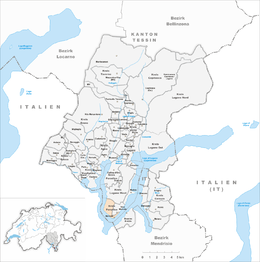Morcote
| Morcote | ||
|---|---|---|
 |
||
|
||
| Coordinates: 45°55′N 8°55′E / 45.917°N 8.917°ECoordinates: 45°55′N 8°55′E / 45.917°N 8.917°E | ||
| Country | Switzerland | |
| Canton | Ticino | |
| District | Lugano | |
| Government | ||
| • Mayor | Sindaco | |
| Area | ||
| • Total | 2.8 km2 (1.1 sq mi) | |
| Elevation | 272 m (892 ft) | |
| Population (Dec 2015) | ||
| • Total | 769 | |
| • Density | 270/km2 (710/sq mi) | |
| Postal code | 6922 | |
| SFOS number | 5203 | |
| Surrounded by | Brusimpiano (IT-VA), Brusino Arsizio, Lugano, Porto Ceresio (IT-VA), Vico Morcote | |
| Twin towns | Viarmes (France) | |
| Website |
www SFSO statistics |
|
Morcote is a municipality in the Swiss canton of Ticino situated about 10 kilometres from Lugano in the district of Lugano on the shore of Lake Lugano.
With its characteristic small alleys, the arcades of old Patrician homes, valuable architectural monuments and its natural beauty, the lakefront position, Morcote is considered "the Pearl of Ceresio".
Morcote is first mentioned historically in 926 as Murcau, which comes from the Latin Morae caput, meaning head of the hill. In 1353 it was mentioned as Murchoe and again in 1453 as Murchote.
Starting around 1100, Morcote was home to a castle that was built to guard and control commerce on the lake. Until the dam was built in Melide in 1847, Morcote was the largest port on Lake Lugano. Goods from northern Italy were shipped across the lake to the rest of Ticino. In 1422 the town was granted privileges by the Duke of Milan, which included the rights to impose taxes, self-government, independent fishing and the right to hold markets. After the plague year of 1432, only seven families survived in the town. The town was often caught between the rival powers of Milan and Como as they fought for control in Lombardy. In 1517 the region came under the control of the Old Swiss Confederation, and was added to the Vogtei of Lugano. However Morcote retained extensive rights, including judicial and tax autonomy as well as fishing rights over the entire lake.
During the Late Middle Ages the major industries of Morcote included fishing, farming and shipping. During the end of the Middle Ages, artists began to move into the town as well. In 1583 the town had a self-supporting parish established in the parish church Santa Maria del Sasso, which dated from the 13th century.
...
Wikipedia



